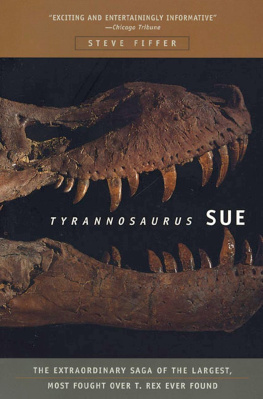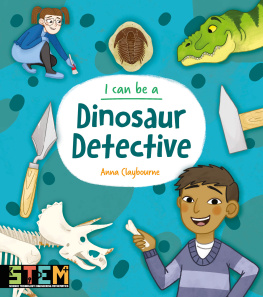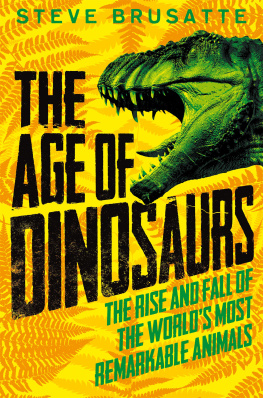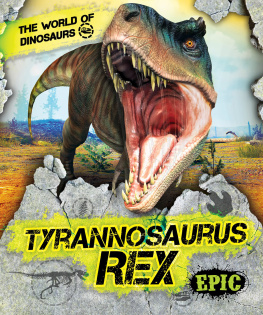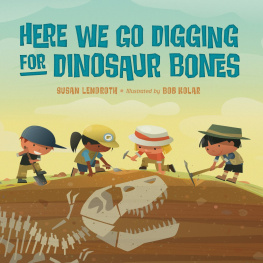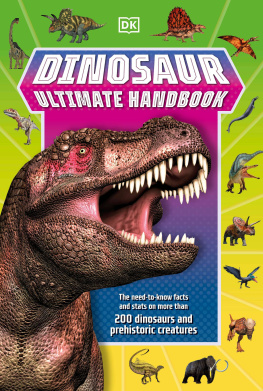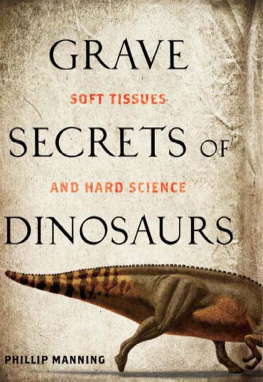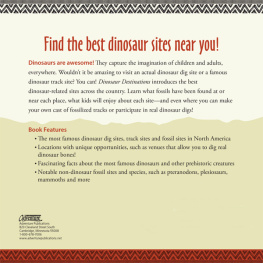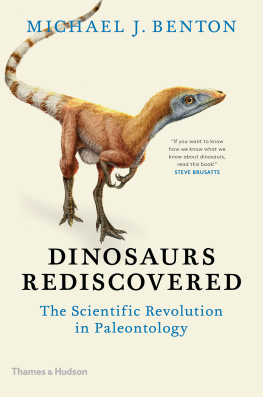Foreword
Robert T. Bakker, PhD
Dinosaurs are the most popular form of fossilized life the world over.
And Tyrannosaurus rex is the most popular dinosaur among people of all ages, all cultures, and all nationalities. And the great skeleton called Sue is, by far, the most famous single skeleton of the tyrant lizard king ever found. A specimen of surpassing beauty, Sue can stun into silence even the most jaded and cynical senior scientist. Scholars everywhere agree that these bones are of tremendous importance in our understanding of the final days of the dinosaurs 66 million years ago, when the Age of Reptiles was about to end in worldwide catastrophe, and the legions of furry mammals were poised to take over the land ecosystems and evolve into horses and tigers, lemurs and monkeys, apes and mankind.
The story of Sue is an extraordinary taleit has the romance of a paleontological quest, the search for the perfect rex by a young fossil hunter who, as a kid, dreamed of building a museum around a tyrannosaur specimen. The story has heartbreaking twists and turns, betrayals and palace intrigues, terrible moments of justice gone wrong when the best intentions were rewarded by calumny and imprisonment. Then there are unlikely protagonists: squads of fourth-grade children from Hill City, South Dakota, who tearfully pleaded with the FBI not to take their beloved tyrannosaur away; McDonalds and Disney, who rushed in their forces to save the skeleton from the ignominious fate of becoming the personal trinket of some international financier.
As the most perfect T. rex ever found, Sue belongs to the world. But she also belongs to Chicago, the city that hosts the Field Museum of Natural History, one of the oldest and grandest of Americas fossil institutions. Here Sue, at last, has found a home, where she rises once more on her gigantic legs to thrill millions of visitors each year. And Sues story most emphatically belongs to Steve Fiffer, a Chicago journalist who has followed her trail from the badlands of South Dakota through the federal court system and at last into the marble halls of the Field. Fiffer has done more than any other investigator in disentangling the many claims and counterclaims thrown out by dueling scientists and lawyers.
Fiffers success comes from being thorough and being fair and being very smart. I know of no other investigator who has been welcomed equally by the rough-and-tumble folks who dig bones in the dry washes of the West and by PhDs in lab coats who speak in the polysyllabic language of technical paleontology.
Theres a lot of Rashomon in Sues story. Every participant remembers it from a different angle. One mans hero is anothers villain. The supporters of Mr. Peter Larson, the independent fossil collector who dug Sue and made her famous, see him as a role model for anyone who wants to explore the deep past and bring back to life the great creatures of the Mesozoic. To certain segments of the PhDs in tax-supported university museums, Pete and his crew are Mesozoic brigands operating outside the tight circle of scholars trained in the Ivy League or its equivalent in California. When I visit my colleagues in Japan or Mongolia or Russia, I find Peter Larson regarded as a leading rex scientist who has reinvigorated the study of tyrannosaurs both by his discoveries of a half-dozen skeletons and by his bold hypotheses about Sues family life and hunting style. But when I chat with long-time friends in Nebraska museums, professors of geology, the mere mention of the Larson brothers elicits sputtering curses and the most undignified slander.
Fiffers account is a double story line. First, there is the chronicle of discovery, the ripping yarn of how packs of multiple Tyrannosaurus rex lived as top predators in the ecosystem known as the Lance Fauna, the last installment of Cretaceous history, and how this tyrant lizard king let its remains become entombed within the sandbars of ancient rivers flowing sluggishly out into the humid deltas of an inland sea. Buried with the tyrants bones were a wealth of clues about what the rex smelled in the air and felt under their toesthere are beautiful tropical leaves, petrified fruit, and pollen dust that speak of a warm environment closer to present-day Louisiana than to the parched high plains of South Dakota. And there are remains of the tyrants last meal, jagged-edged fragments of toes and ribs bitten off the bodies of Triceratops and still within the gut cavities of the predators skeletons. Inscribed on the rex bones themselves are the scars left by a predaceous lifestylescratches on the cheekbones that were inflicted during ritualized battles with other rex and terrible wounds on legs and ribcages that were products of life-and-death struggles with horned dinosaurs.
The unearthing of these rex graves came in two waves. First came the explorers of 1900 from back East, from New York and from the Smithsonian, men who found the first rex and made tyrannosaur a household word. Nearly a century later, in the 1990s, came the second wave of rex hunters, this time led by men and women from institutions in the Rocky Mountain states, some from state colleges and universities, some from independent museums that grew de novo, coalescing around people such as the Larson brothers and their coworkers in the Black Hills of South Dakota. These independents were not a totally new phenomenon. Since the 1870s there had been Westernersthe Sternberg family from Kansas are the most famouswho made their living by digging dinosaurs and selling the specimens to public museums the world over. The Sternbergs braved horrible blizzards and scorching sandstorms to bring back duck-billed dinosaurs and tyrannosaurs to fill out the core displays in a dozen eastern museums.
When I went to college in the 1960s, the Sternberg legacy was still honored. But the politics of paleontology shifted. In the 1970s and 1980s some PhDs claimed all bones for themselves, declaring that only university scholars such as themselves had the right to dig skeletons and study them. According to this view, the days of the Sternbergs were over. Independent dino hunters were no longer welcome. Then came Sue. The Larson brothers Black Hills Institute excavated the skeleton and began to clean the bones with expert care. And they dared to make their own conclusions about rex lifestyle and relationships. We PhDs are as vulnerable to the twin malady of envy and gossip as are any other segment of society, so as Sues fame grew, resentment spread.
A byzantine tangle of lawsuits and, eventually, criminal charges paralyzed the further study of the Sue skeleton. Political opportunists jumped on the bandwagon, posturing as protectors of the countrys fossil heritage. Men and women of goodwill lined up against each other. Former friends broke off communication.
When the dust settled, millions of taxpayer dollars had been squandered on unnecessary court cases. And Sue was in danger of being auctioned off to any billionaire collector who might want to make the fossil a Cretaceous objet dart for his foyer.
Fiffer tells this double story with wit, clarity, and verve. Heres a fossil saga for everyonefor the dino aficionado who wants to learn secrets of rexian society; for the reader of adventure yarns that are almost too good to be true; for the citizens who suspect that the agents of big government dont always do the right thing. Dinosaur bones are the legacy given to our human species, the only life form with a brain big enough to understand them. Dinosaur fossils are intellectual jumper cablesnothing beats a room full of dino bones to get brains of kids and adults working at full capacity. And to understand dino science, one has to probe the motives of dino scientists. More than any other recent work, Fiffers book gets inside paleontology and shows us how this most magical science really works.

